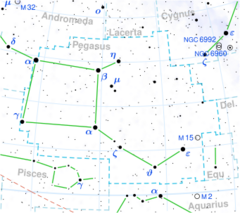Astronomy:Alpha Pegasi
| Observation data Equinox J2000.0]] (ICRS) | |
|---|---|
| Constellation | Pegasus |
| Right ascension | 23h 04m 45.65345s[1] |
| Declination | +15° 12′ 18.9617″[1] |
| Apparent magnitude (V) | 2.48[2] |
| Characteristics | |
| Spectral type | A0 IV[3] |
| U−B color index | –0.06[2] |
| B−V color index | –0.04[2] |
| Variable type | suspected[4] |
| Astrometry | |
| Radial velocity (Rv) | –2.2[5] km/s |
| Proper motion (μ) | RA: 60.40 ± 0.17[1] mas/yr Dec.: -41.30 ± 0.16[1] mas/yr |
| Parallax (π) | 24.46 ± 0.19[1] mas |
| Distance | 133 ± 1 ly (40.9 ± 0.3 pc) |
| Absolute magnitude (MV) | –0.718[6] |
| Details | |
| Mass | 3.5[7] M☉ |
| Radius | 4.62±0.29[8] R☉ |
| Luminosity | 165[9] L☉ |
| Surface gravity (log g) | 3.98±0.25[8] cgs |
| Temperature | 10,100±100[8] K |
| Metallicity [Fe/H] | −0.28[10] dex |
| Rotational velocity (v sin i) | 130[8] km/s |
| Age | 200[7] Myr |
| Other designations | |
| Database references | |
| SIMBAD | data |
Alpha Pegasi (α Pegasi, abbreviated Alpha Peg, α Peg), formally named Markab /ˈmɑːrkæb/,[11][12] is the third-brightest star in the constellation of Pegasus and one of the four stars in the asterism known as the Great Square of Pegasus.
Properties
Alpha Pegasi has a stellar classification of A0 IV, indicating that it is an A-type subgiant star that has exhausted the hydrogen at its core and has evolved beyond the main sequence. Its spectrum has also been classified as B9V[13] and B9.5III.[14]
It is rotating rapidly, with a projected rotational velocity of 130 km/s giving a lower bound on the azimuthal velocity along the star's equator. The effective temperature of the photosphere is about 10,000 K and the star has expanded to nearly five times the radius of the Sun, emitting 165 times as much energy as the sun.
Nomenclature
α Pegasi (Latinised to Alpha Pegasi) is the star's Bayer designation. It bore the traditional name Markab (or Marchab), which derived from an Arabic word مركب markab "the saddle of the horse", or is mistranscription of Mankib, which itself comes from an Arabic phrase منكب الفرس Mankib al-Faras "(the Star of) the Shoulder (of the Constellation) of the Horse" for Beta Pegasi.
In 2016, the International Astronomical Union organized a Working Group on Star Names (WGSN)[15] to catalog and standardize proper names for stars. The WGSN's first bulletin of July 2016 included a table of the first two batches of names approved by the WGSN, which included Markab for this star.[16]
In Chinese, 室宿 (Shì Xiù), meaning Encampment, refers to an asterism consisting α Pegasi and β Pegasi.[17] Consequently, the Chinese name for α Pegasi itself is 室宿一 (Shì Xiù yī), "the First Star of Encampment".[18]
References
- ↑ 1.0 1.1 1.2 1.3 1.4 van Leeuwen, F. (November 2007). "Validation of the new Hipparcos reduction". Astronomy and Astrophysics 474 (2): 653–664. doi:10.1051/0004-6361:20078357. Bibcode: 2007A&A...474..653V.
- ↑ 2.0 2.1 2.2 Johnson, H. L. et al. (1966). "UBVRIJKL photometry of the bright stars". Communications of the Lunar and Planetary Laboratory 4 (99): 99. Bibcode: 1966CoLPL...4...99J.
- ↑ Abt, Helmut A.; Morrell, Nidia I. (1995). "The Relation between Rotational Velocities and Spectral Peculiarities among A-Type Stars". Astrophysical Journal Supplement 99: 135. doi:10.1086/192182. Bibcode: 1995ApJS...99..135A.
- ↑ Samus, N. N. et al. (2009). "VizieR Online Data Catalog: General Catalogue of Variable Stars (Samus+ 2007-2013)". VizieR On-line Data Catalog: B/GCVS. Originally Published in: 2009yCat....102025S 1. Bibcode: 2009yCat....102025S.
- ↑ Wielen, R. et al. (1999). "Sixth Catalogue of Fundamental Stars (FK6). Part I. Basic fundamental stars with direct solutions". Veröff. Astron. Rechen-Inst. Heidelb (Astronomisches Rechen-Institut Heidelberg) 35 (35): 1. Bibcode: 1999VeARI..35....1W.
- ↑ Katz, D.; Soubiran, C.; Cayrel, R.; Barbuy, B.; Friel, E.; Bienaymé, O.; Perrin, M. -N. (2011). "Probing the Galactic thick disc vertical properties and interfaces". Astronomy and Astrophysics 525: A90. doi:10.1051/0004-6361/201014840. Bibcode: 2011A&A...525A..90K.
- ↑ 7.0 7.1 De Rosa, R. J. et al. (January 2014). "The VAST Survey - III. The multiplicity of A-type stars within 75 pc". Monthly Notices of the Royal Astronomical Society 437 (2): 1216–1240. doi:10.1093/mnras/stt1932. Bibcode: 2014MNRAS.437.1216D.
- ↑ 8.0 8.1 8.2 8.3 Gordon, Kathryn D.; Gies, Douglas R.; Schaefer, Gail H.; Huber, Daniel; Ireland, Michael (2019). "Angular Sizes, Radii, and Effective Temperatures of B-type Stars from Optical Interferometry with the CHARA Array". The Astrophysical Journal 873 (1): 91. doi:10.3847/1538-4357/ab04b2. Bibcode: 2019ApJ...873...91G.
- ↑ McDonald, I.; Zijlstra, A. A.; Watson, R. A. (2017). "Fundamental parameters and infrared excesses of Tycho–Gaia stars". Monthly Notices of the Royal Astronomical Society 471 (1): 770–791. doi:10.1093/mnras/stx1433. Bibcode: 2017MNRAS.471..770M.
- ↑ Gáspár, András et al. (2016). "The Correlation between Metallicity and Debris Disk Mass". The Astrophysical Journal 826 (2): 171. doi:10.3847/0004-637X/826/2/171. Bibcode: 2016ApJ...826..171G.
- ↑ Kunitzsch, Paul; Smart, Tim (2006). A Dictionary of Modern star Names: A Short Guide to 254 Star Names and Their Derivations (2nd rev. ed.). Cambridge, Massachusetts: Sky Pub. ISBN 978-1-931559-44-7.
- ↑ "IAU Catalog of Star Names". http://www.pas.rochester.edu/~emamajek/WGSN/IAU-CSN.txt.
- ↑ Hoffleit, D; Warren, W. H (1995). "VizieR Online Data Catalog: Bright Star Catalogue, 5th Revised Ed. (Hoffleit+, 1991)". VizieR On-line Data Catalog: V/50. Originally Published in: 1964BS....C......0H 5050. Bibcode: 1995yCat.5050....0H.
- ↑ Osawa, Kiyoteru (1959). "Spectral Classification of 533 B8-A2 Stars and the Mean Absolute Magnitude of A0 V Stars". Astrophysical Journal 130: 159. doi:10.1086/146706. Bibcode: 1959ApJ...130..159O.
- ↑ "IAU Working Group on Star Names (WGSN)". https://www.iau.org/science/scientific_bodies/working_groups/280/.
- ↑ "Bulletin of the IAU Working Group on Star Names, No. 1". http://www.pas.rochester.edu/~emamajek/WGSN/WGSN_bulletin1.pdf.
- ↑ (in Chinese) 中國星座神話, written by 陳久金. Published by 台灣書房出版有限公司, 2005, ISBN:978-986-7332-25-7.
- ↑ (in Chinese) 香港太空館 - 研究資源 - 亮星中英對照表 , Hong Kong Space Museum. Accessed on line November 23, 2010.
 |


